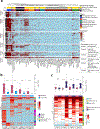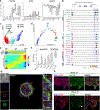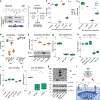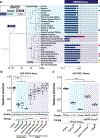Evolution and antiviral activity of a human protein of retroviral origin
- PMID: 36302021
- PMCID: PMC10542854
- DOI: 10.1126/science.abq7871
Evolution and antiviral activity of a human protein of retroviral origin
Abstract
Endogenous retroviruses are abundant components of mammalian genomes descended from ancient germline infections. In several mammals, the envelope proteins encoded by these elements protect against exogenous viruses, but this activity has not been documented with endogenously expressed envelopes in humans. We report that the human genome harbors a large pool of envelope-derived sequences with the potential to restrict retroviral infection. To test this, we characterized an envelope-derived protein, Suppressyn. We found that Suppressyn is expressed in human preimplantation embryos and developing placenta using its ancestral retroviral promoter. Cell culture assays showed that Suppressyn, and its hominoid orthologs, could restrict infection by extant mammalian type D retroviruses. Our data support a generalizable model of retroviral envelope co-option for host immunity and genome defense.
Conflict of interest statement
Figures




Comment in
-
Stealing genes and facing consequences.Science. 2022 Oct 28;378(6618):356-357. doi: 10.1126/science.ade4942. Epub 2022 Oct 27. Science. 2022. PMID: 36302006
-
Viral protection from viruses.Nat Rev Genet. 2023 Jan;24(1):2. doi: 10.1038/s41576-022-00557-7. Nat Rev Genet. 2023. PMID: 36414715 No abstract available.
Similar articles
-
Identification of an endogenous retroviral envelope gene with fusogenic activity and placenta-specific expression in the rabbit: a new "syncytin" in a third order of mammals.Retrovirology. 2009 Nov 27;6:107. doi: 10.1186/1742-4690-6-107. Retrovirology. 2009. PMID: 19943933 Free PMC article.
-
A novel human endogenous retroviral protein inhibits cell-cell fusion.Sci Rep. 2013;3:1462. doi: 10.1038/srep01462. Sci Rep. 2013. PMID: 23492904 Free PMC article.
-
Capture of syncytin-Mar1, a fusogenic endogenous retroviral envelope gene involved in placentation in the Rodentia squirrel-related clade.J Virol. 2014 Jul;88(14):7915-28. doi: 10.1128/JVI.00141-14. Epub 2014 Apr 30. J Virol. 2014. PMID: 24789792 Free PMC article.
-
Paleovirology of 'syncytins', retroviral env genes exapted for a role in placentation.Philos Trans R Soc Lond B Biol Sci. 2013 Aug 12;368(1626):20120507. doi: 10.1098/rstb.2012.0507. Print 2013 Sep 19. Philos Trans R Soc Lond B Biol Sci. 2013. PMID: 23938756 Free PMC article. Review.
-
Contribution of Syncytins and Other Endogenous Retroviral Envelopes to Human Placenta Pathologies.Prog Mol Biol Transl Sci. 2017;145:111-162. doi: 10.1016/bs.pmbts.2016.12.005. Epub 2017 Jan 16. Prog Mol Biol Transl Sci. 2017. PMID: 28110749 Review.
Cited by
-
Transposable elements may enhance antiviral resistance in HIV-1 elite controllers.bioRxiv [Preprint]. 2023 Dec 12:2023.12.11.571123. doi: 10.1101/2023.12.11.571123. bioRxiv. 2023. PMID: 38168352 Free PMC article. Preprint.
-
Reactivation of a somatic errantivirus and germline invasion in Drosophila ovaries.Nat Commun. 2023 Sep 29;14(1):6096. doi: 10.1038/s41467-023-41733-5. Nat Commun. 2023. PMID: 37773253 Free PMC article.
-
Retrotransposon life cycle and its impacts on cellular responses.RNA Biol. 2024 Jan;21(1):11-27. doi: 10.1080/15476286.2024.2409607. Epub 2024 Oct 13. RNA Biol. 2024. PMID: 39396200 Free PMC article. Review.
-
Virus-Induced Cell Fusion and Syncytia Formation.Results Probl Cell Differ. 2024;71:283-318. doi: 10.1007/978-3-031-37936-9_14. Results Probl Cell Differ. 2024. PMID: 37996683
-
The Interplay Between Developmental Stage and Environment Underlies the Adaptive Effect of a Natural Transposable Element Insertion.Mol Biol Evol. 2023 Mar 4;40(3):msad044. doi: 10.1093/molbev/msad044. Mol Biol Evol. 2023. PMID: 36811953 Free PMC article.
References
-
- Johnson WE, Origins and evolutionary consequences of ancient endogenous retroviruses. Nature reviews. Microbiology. 72, 5955 (2019). - PubMed
Publication types
MeSH terms
Substances
Grants and funding
LinkOut - more resources
Full Text Sources
Other Literature Sources

